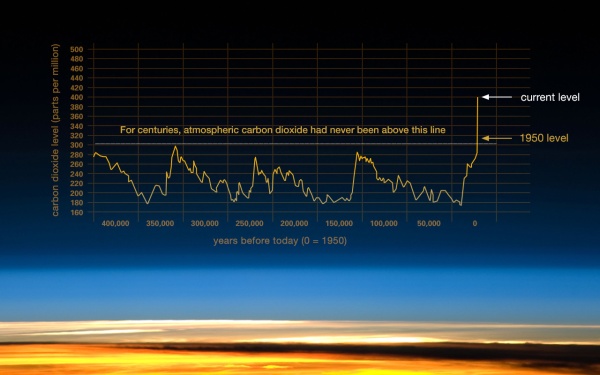Global
CO2 Spike Spurs Hottest June on Record, Extreme Weather For US
7 July, 2016
According to NOAA, the United States just experienced its hottest June ever recorded in the whole of the national climate record starting 122 years ago in 1895. That’s an average temperature of 71.8 F (22.1 C) across the contiguous United States — or 3.3 F (1.83 C) hotter than a typical June.
(The United States just experienced its hottest June on record. The extreme heat comes alongside a period of record global warmth and helped to spur numerous extreme weather events across the country. Image source: NOAA.)
The new national June record broke the old record set back in 1933 and comes amidst a 13 month long streak of record hot months in the NOAA Climate measure. The record US heat also coincided with an extreme Southwestern heatwave, an apparently unquenchable California drought, record low Lake Mead water levels amidst a 16 year drought in the Colorado River basin, severe US wildfires, and the worst flooding in a hundred years to strike West Virginia.
Record heat — both at the national and at the global level — is a well-known driver of extreme weather events such as wildfires, droughts, and deluges. And NOAA shows that six of the past nine years have seen far above average damages due to severe weather — with 2016 tracking near the all time worst year (2011) for number of billion + dollar disaster events. Meanwhile, extreme weather attribution studies are increasingly providing a physical science basis for linking single and regional events with the larger global warming trend.
Heat Driven By Spiking Carbon Dioxide Levels
At the same time that national temperatures were hitting new record highs, average carbon dioxide levels measured by the Mauna Loa Observatory saw record rates of rise for the month. According to NOAA’s Earth Systems Research Laboratory, June of 2016 saw average carbon dioxide levels that were 4.01 parts per million higher than June of 2015. That’s a huge jump in the atmospheric concentration of a greenhouse gas that rose by about 1 part per million every year during the 1960s and during recent years has risen by an average of about 2 parts per million.
(NASA graphic provides a stark paleoclimate contrast to the human carbon dioxide spike. The current rate of increase in atmospheric CO2 levels is faster than at any time in the last 60 million years and, possibly, faster than for any period in which life occupied planet Earth. Image source: NASA.)
Last year saw a record annual rate of atmospheric CO2 increase of around 3.05 parts per million. But the first six months of 2016 have so far greatly outstripped even 2015’s nasty rise — currently tracking 3.59 parts per million above the first six months of the previous year.
Record global greenhouse gas levels and a spike that is essentially vertical on geological timescales are, in greatest portion, driven by human fossil fuel emissions. These spiking levels of heat trapping gasses, in turn, drive extreme global temperatures and related severe weather events. But as the world’s land and ocean surfaces heat up, they tend to also draw in less of the human carbon emission even as they emit more. Expanding deserts, worsening wildfires, expanding ocean hot pools and thawing permafrost all add to this vicious cycle. And it’s possible that we’re starting to see rumor of these amplifying feedbacks starting to kick in now. Which makes the continued burning of fossil fuel that drives the whole vicious cycle an ever more dangerous prospect.
Links/Attribution/Statements:
Scientific hat tip to Dr. Stefan Rahmstorf
Hat tip to DT Lange
Hat tip to Greg
Hat tip to Suzanne





No comments:
Post a Comment
Note: only a member of this blog may post a comment.